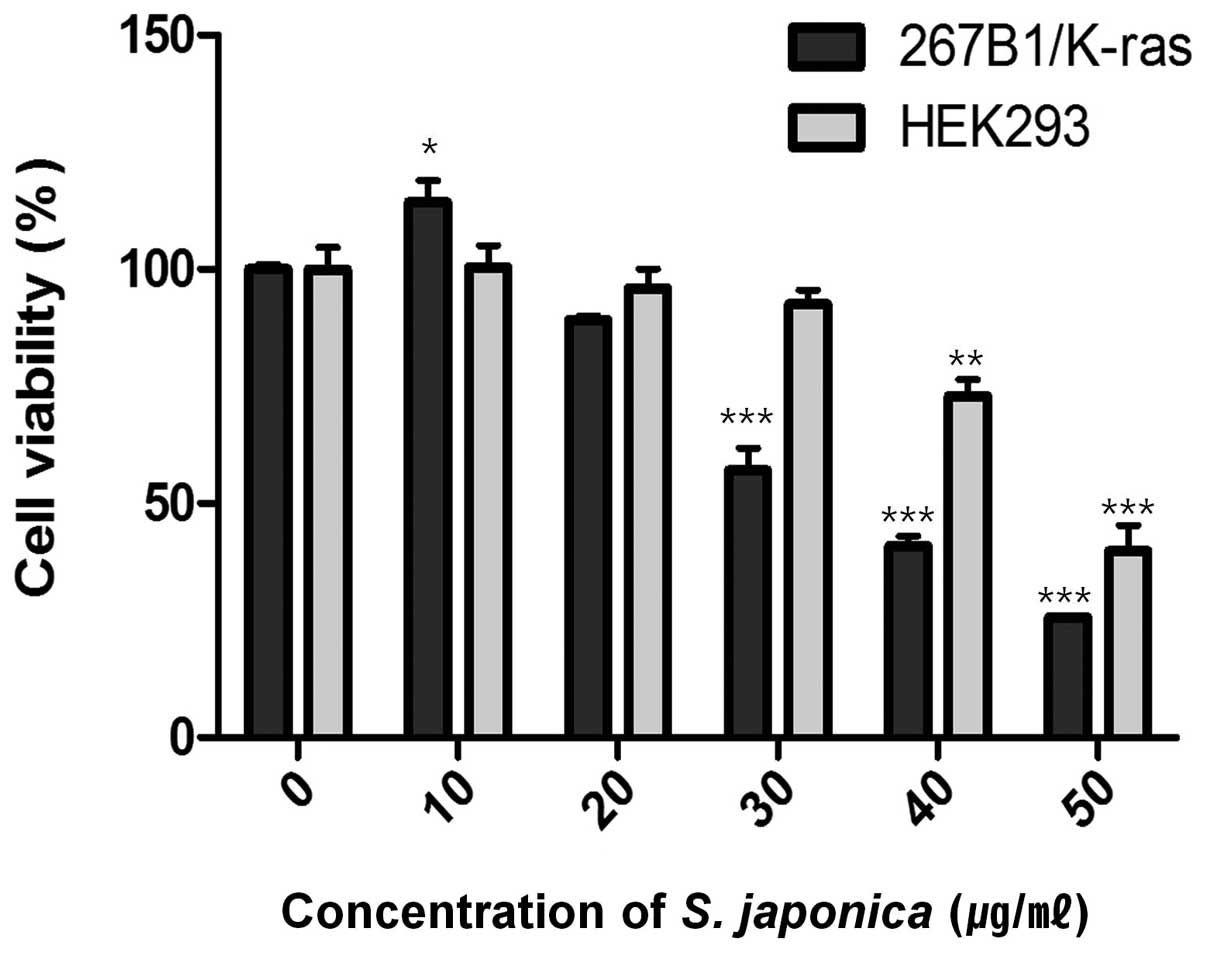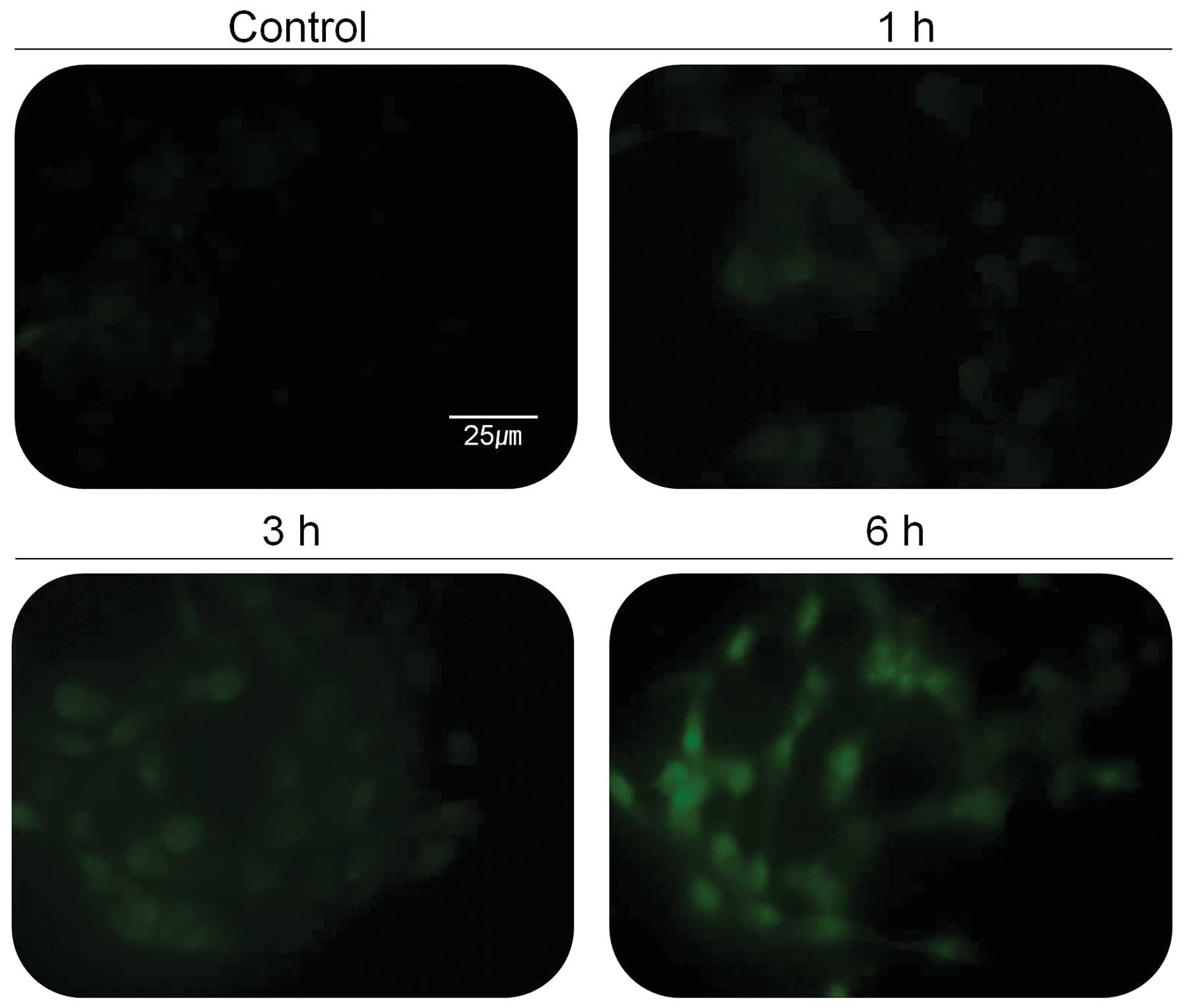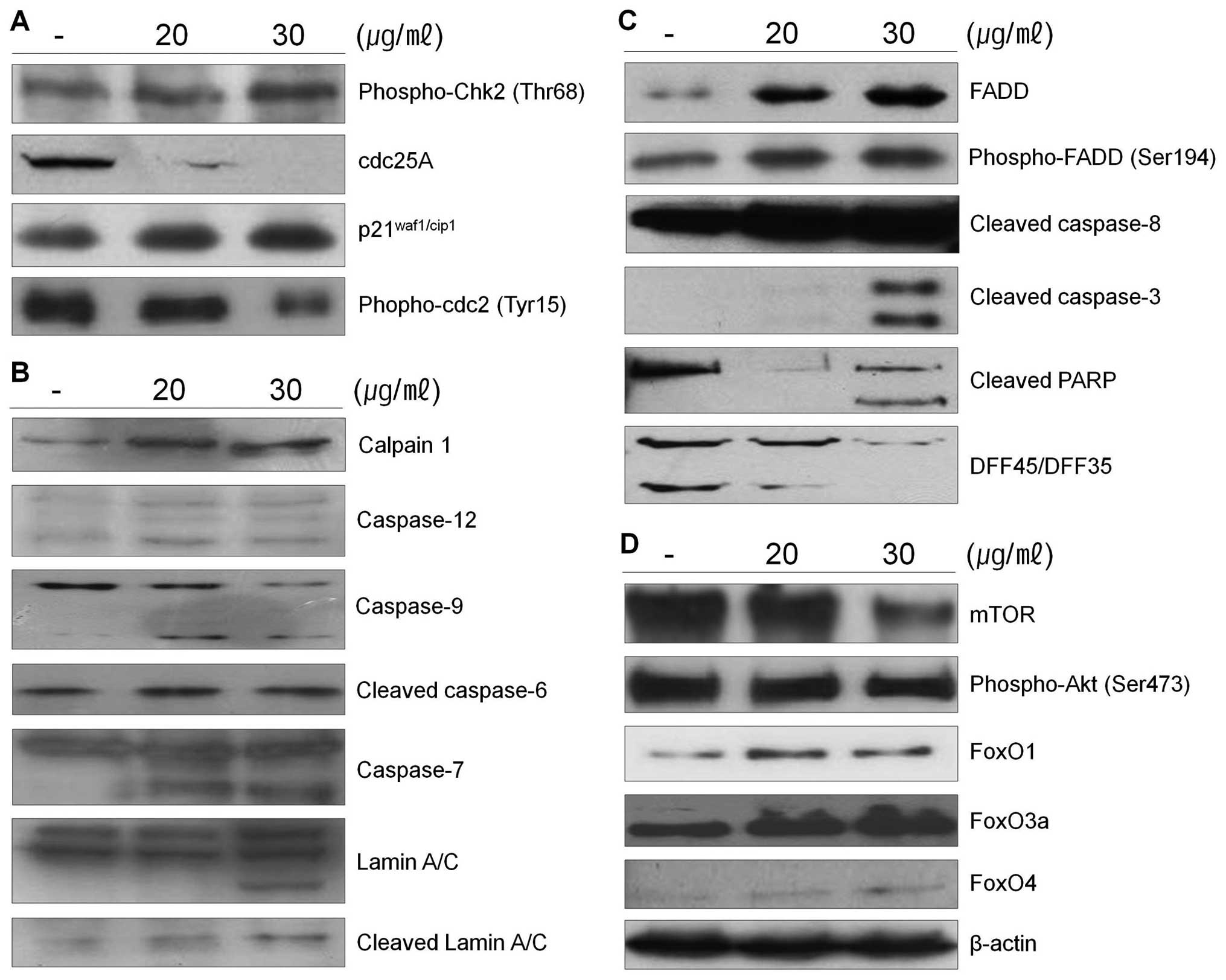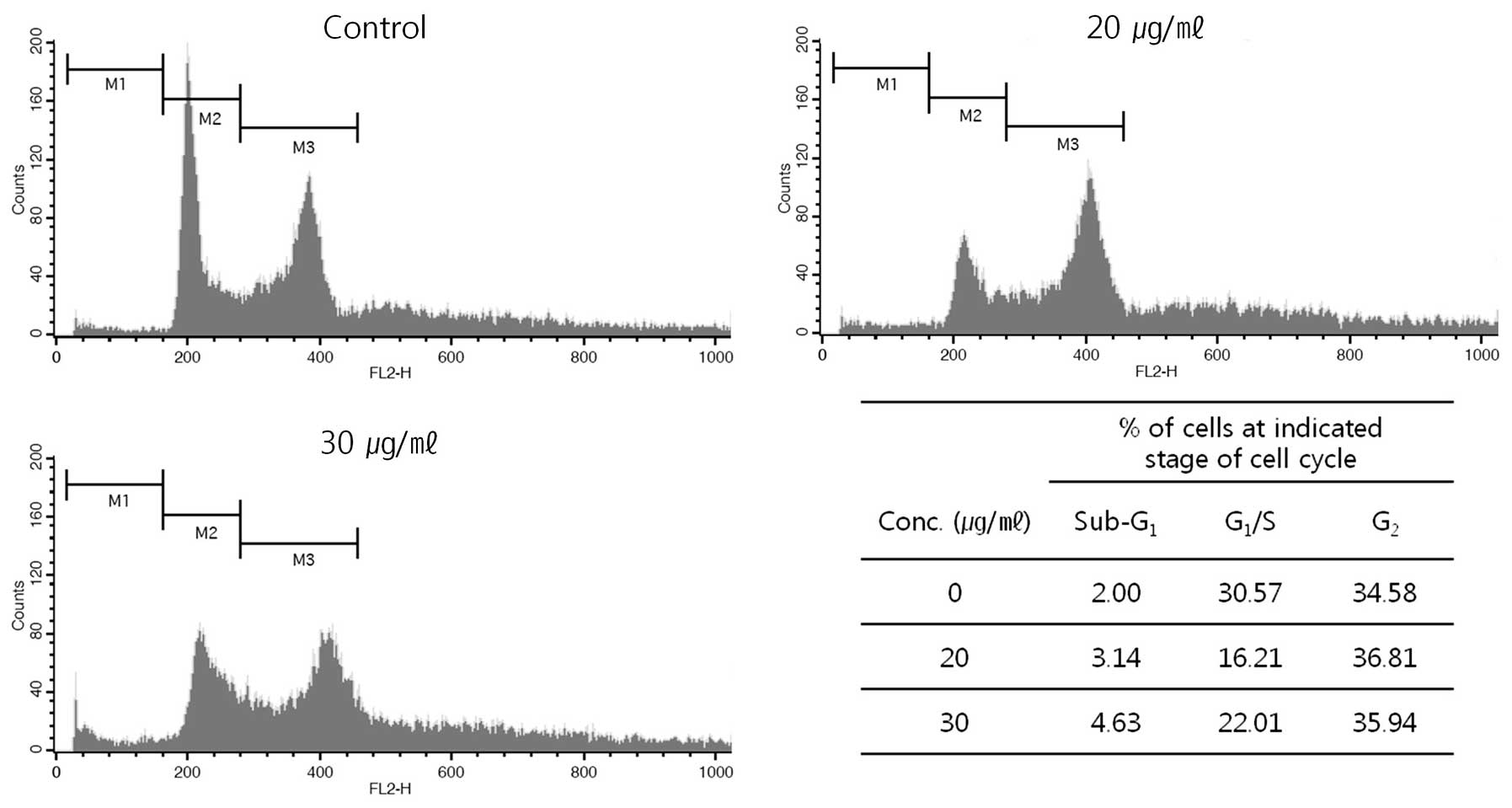|
1.
|
Parda DS, Thraves PJ, Kuettel MR, et al:
Neoplastic transformation of a human prostate epithelial cell line
by the v-Ki-ras oncogene. Prostate. 23:91–98. 1993. View Article : Google Scholar : PubMed/NCBI
|
|
2.
|
Wynder EL, Rose DP and Cohen LA: Nutrition
and prostate cancer: a proposal for dietary intervention. Nutr
Cancer. 22:1–10. 1994. View Article : Google Scholar : PubMed/NCBI
|
|
3.
|
Giovannucci E: Epidemiologic
characteristics of prostate cancer. Cancer. 75:1766–1777. 1995.
View Article : Google Scholar
|
|
4.
|
Stan SD, Kar S, Stoner GD and Singh SV:
Bioactive food components and cancer risk reduction. J Cell
Biochem. 104:339–356. 2008. View Article : Google Scholar : PubMed/NCBI
|
|
5.
|
Booth E: Trace elements and seaweeds.
Proceeding of the 4th International seaweed symposium. De Virville
AD and Feldmann J: MacMillan; London: pp. 385–393. 1964
|
|
6.
|
Yan X, Chuda Y, Suzuki M and Nagata T:
Fucoxanthin as the major antioxidant in Hijikia fusiformis, a
common edible seaweed. Biosci Biotechnol Biochem. 63:605–607. 1999.
View Article : Google Scholar : PubMed/NCBI
|
|
7.
|
Munro MHG, Blunt JW, Dumdei EJ, et al: The
discovery and development of marine compounds with pharmaceutical
potential. J Biotechnol. 70:15–25. 1999. View Article : Google Scholar : PubMed/NCBI
|
|
8.
|
Rice-Evans C, Miller N and Paganga G:
Antioxidant properties of phenolic compounds. Trends Plant Sci.
2:152–159. 1997. View Article : Google Scholar
|
|
9.
|
Yuan YV and Walsh NA: Antioxidant and
antiproliferative activities of extracts from a variety of edible
seaweeds. Food Chem Toxicol. 44:1144–1150. 2006. View Article : Google Scholar : PubMed/NCBI
|
|
10.
|
Lee NY, Ermakova SP, Zvyagintseva TN, Kang
KW, Dong Z and Choi HS: Inhibitory effects of fucoidan on
activation of epidermal growth factor receptor and cell
transformation in JB6 Cl41 cells. Food Chem Toxicol. 46:1793–1800.
2008. View Article : Google Scholar : PubMed/NCBI
|
|
11.
|
Lieberthal W, Koh JS and Levine JS:
Necrosis and apoptosis in acute renal failure. Semin Nephrol.
18:505–518. 1998.PubMed/NCBI
|
|
12.
|
Zimmermann KC, Bonzon C and Green DR: The
machinery of programmed cell death. Pharmacol Ther. 92:57–70. 2001.
View Article : Google Scholar : PubMed/NCBI
|
|
13.
|
Cryns VL, Bergeron L, Zhu H, Li H and Yuan
J: Specific cleavage of α-fodrin during Fas-and tumor necrosis
factor-induced apoptosis is mediated by an
interleukin-1β-converting enzyme/Ced-3 protease distinct from the
poly(ADP-ribose) polymerase protease. J Biol Chem. 271:31277–31282.
1996.
|
|
14.
|
Kothakota S, Azuma T, Reinhard C, et al:
Caspase-3-generated fragment of gelsolin: effector of morphological
change in apoptosis. Science. 278:294–298. 1997. View Article : Google Scholar : PubMed/NCBI
|
|
15.
|
Lazebnik Y, Kaufmann S, Desnoyers S,
Poirier G and Earnshaw W: Cleavage of poly(ADP-ribose) polymerase
by a proteinase with properties like ICE. Nature. 371:346–347.
1994. View
Article : Google Scholar : PubMed/NCBI
|
|
16.
|
Lazebnik YA, Takahashi A, Moir RD, et al:
Studies of the lamin proteinase reveal multiple parallel
biochemical pathways during apoptotic execution. Proc Natl Acad Sci
USA. 92:9042–9046. 1995. View Article : Google Scholar : PubMed/NCBI
|
|
17.
|
Mashima T, Naito M, Fujita N, Noguchi K
and Tsuruo T: Identification of actin as a substrate of ICE and an
ICE-like protease and involvement of an ICE-like protease but not
ICE in VP-16-induced U937 apoptosis. Biochem Biophys Res Commun.
217:1185–1192. 1995. View Article : Google Scholar : PubMed/NCBI
|
|
18.
|
Sakahira H, Enari M and Nagata S: Cleavage
of CAD inhibitor in CAD activation and DNA degradation during
apoptosis. Nature. 391:96–99. 1998. View
Article : Google Scholar : PubMed/NCBI
|
|
19.
|
Sherr CJ: Gl phase progression: cycling on
cue. Cell. 79:551–555. 1994. View Article : Google Scholar : PubMed/NCBI
|
|
20.
|
Xiong Y, Hannon G, Zhang H, Casso D,
Kobayashi R and Beach D: p21 is a universal inhibitor of cyclin
kinases. Nature. 366:701–704. 1993. View
Article : Google Scholar : PubMed/NCBI
|
|
21.
|
Kwon O, Kim KA, Kim SO, et al: NF-κB
inhibition increases chemosensitivity to trichostatin A-induced
cell death of Ki-Ras-transformed human prostate epithelial cells.
Carcinogenesis. 27:2258–2268. 2006.
|
|
22.
|
Kuo PL, Hsu YL, Cho CY, Ng LT, Kuo YH and
Lin CC: Apoptotic effects of Antrodia cinnamomea1 fruiting bodies
extract are mediated through calcium and calpain-dependent pathways
in Hep 3B cells. Food Chem Toxicol. 44:1316–1326. 2006. View Article : Google Scholar : PubMed/NCBI
|
|
23.
|
Rasheva VI and Domingos PM: Cellular
responses to endoplasmic reticulum stress and apoptosis. Apoptosis.
14:996–1007. 2009. View Article : Google Scholar : PubMed/NCBI
|
|
24.
|
Muzio M, Chinnaiyan AM, Kischkel FC, et
al: FLICE, a novel FADD-homologous ICE/CED-3-like protease, is
recruited to the CD95 (Fas/APO-1) death-inducing signaling complex.
Cell. 85:817–827. 1996. View Article : Google Scholar : PubMed/NCBI
|
|
25.
|
Sabatini DM: mTOR and cancer: insights
into a complex relationship. Nat Rev Cancer. 6:729–734. 2006.
View Article : Google Scholar : PubMed/NCBI
|
|
26.
|
Park SJ, Sohn HY, Yoon J and Park SI:
Down-regulation of FoxO-dependent c-FLIP expression mediates
TRAIL-induced apoptosis in activated hepatic stellate cells. Cell
Signal. 21:1495–1503. 2009. View Article : Google Scholar : PubMed/NCBI
|
|
27.
|
Oberhammer FA, Hochegger K, Fröschl G,
Tiefenbacher R and Pavelka M: Chromatin condensation during
apoptosis is accompanied by degradation of lamin A+B, without
enhanced activation of cdc2 kinase. J Cell Biol. 126:827–837.
1994.
|
|
28.
|
Sørensen CS, Syljuåsen RG, Falck J, et al:
Chk1 regulates the S phase checkpoint by coupling the physiological
turnover and ionizing radiation-induced accelerated proteolysis of
Cdc25A. Cancer Cell. 3:247–258. 2003.PubMed/NCBI
|
|
29.
|
Gartel AL and Tyner AL: The role of the
cyclin-dependent kinase inhibitor p21 in apoptosis 1 supported in
part by NIH grant R01 DK56283 (to ALT) for the p21 research and
Campus Research Board and Illinois Department of Public Health
Penny Severns Breast and Cervical Cancer grants (to ALG). 1. Mol
Cancer Ther. 1:6392002.
|
















